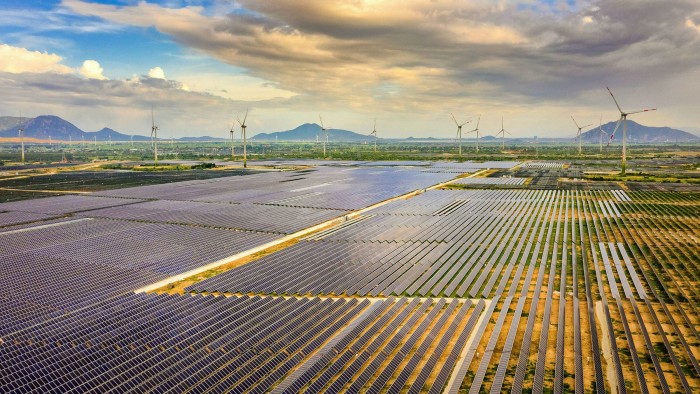Low-income countries play carbon leapfrog in green energy shift

Simply sign up to the Renewable energy myFT Digest -- delivered directly to your inbox.
Just as Brazil’s rivers supply it with hydroelectric power and faults in the earth’s crust provide Indonesia with geothermal energy, so Vietnam hopes abundant sunshine and a shallow coast will provide clean energy to drive economic growth.
Like many low- and middle-income countries, it is under pressure to generate sufficient energy to power its industries while keeping the economy as green as possible.
In Vietnam, a country of almost 100m people that saw gross domestic product growth of 7 per cent in 2019, energy consumption has more than doubled since 2010 — although the average Vietnamese uses half as much electricity as someone in neighbouring China.
But efforts by smaller, industrialising nations can still make a big difference in the fight against climate change. “Adding a renewable project into a developing country’s power grid tends to offset or replace a higher proportion of fossil fuels than it would in a developed country,” explains Steve Liberatore, head of ESG fixed income strategies at Nuveen, an asset manager.
The UN’s Emissions Gap Report 2020 says that success in managing the transition to green energy could lead to developing countries leapfrogging beyond the carbon-intensive technologies that underpin wealthier nations.
Twice weekly newsletter

Energy is the world’s indispensable business and Energy Source is its newsletter. Every Tuesday and Thursday, direct to your inbox, Energy Source brings you essential news, forward-thinking analysis and insider intelligence. Sign up here.
In Vietnam’s case, the sea off its southern coast is ideal for placing offshore wind turbines, which are crucial to the south-east Asian country’s plan to increase its proportion of power from wind and solar from 10 per cent in 2019 to 42 per cent of the national grid by 2045.
“To illustrate how impressive Vietnam’s renewable energy adoption has been . . . [it] did not have any utility-scale solar power until 2018, and very little wind,” says Thu Vu, an energy finance analyst at the Institute for Energy Economics and Financial Analysis, an Ohio think-tank.
However, the draft version of PDP8, Vietnam’s national power development plan, has underestimated the pace of its energy transition, says Vu. According to data from Irena, an intergovernmental renewable energy organisation, Vietnam’s production from solar and wind increased 237 per cent and 60 per cent respectively in 2020, raising the share of these sources to a quarter — almost a decade ahead of schedule.
Although most of its existing wind projects are located onshore, restrictions on available land mean the bulk of Vietnam’s windpower gains will have to come from offshore wind farms, says the Danish Energy Agency, which advises the Vietnamese government.
Vietnam’s southern coast does not lack wind. With average speeds of more than 10 metres a second — force six on the Beaufort scale — its territorial waters rank in the top 10 per cent of the windiest places on the planet.
“Many other countries in the region also have good wind speeds but they are limited by deep seas,” says Adrian Dempsey, Asia-Pacific chief financial officer at Mainstream Renewable Power, an Irish energy company with operations in Vietnam.
The seas off the provinces of Binh Thuan and Soc Trang — where developers including Mainstream plan to build multibillion-dollar offshore wind farms — are also relatively shallow, with depths of 20 metres to 50 metres.
According to the World Bank, developing Vietnam’s maritime assets could produce 475GW of electricity a year — about 20 times the country’s total potential capacity for onshore wind power. Yet, despite its potential to supply Vietnam’s energy needs, few large-scale offshore projects have been added under the proposed PDP8 — mainly because of regulatory complexity and investment risk.
“The 2030 target for offshore wind is limited at 2GW-3GW, [which] reflects the government’s scepticism for now,” says Vu, noting the higher cost of offshore units relative to onshore or nearshore wind.
To reduce costs, Vietnam must improve its infrastructure, says Ian Hatton, chair of Enterprize Energy, a UK-renewable energy company. It could do this by linking up the energy-charged south to its northern cities, building substations, and laying cables along the seabed for offshore production, or finding alternative solutions. Enterprize is experimenting with converting wind energy and seawater to hydrogen.
More stories from this report
Energy grids of the future steeled for big changes
Plastics-to-oil recyclers face a double struggle
Carbon capture eyes renewed backing despite past failures
Gas prospects lose steam as low-carbon shift gathers pace
Carbon price is missing from Biden’s overhaul of climate policy
Positive outlook for batteries in Australia renewables shift
However, the country’s renewables industry is also a victim of its own success. In 2019, a government feed-in-tariff incentive led to the addition of 4.46GW from 82 solar plants — an oversupply that forced plants to cut output.
It is an example of the dilemma facing low- and middle-income nations such as Vietnam: if they produce enough energy to meet demand without improving transmission infrastructure, additional capacity could be squandered.
According to the Vietnamese government, upgrading its infrastructure and adding generation capacity would require investment of $128.3bn in the next decade, including funding from abroad. But William Gaillard, vice-president of wind turbine manufacturer Vestas, believes Vietnam has “shown a path for others to follow.” He says: “The combination of an attractive feed-in-tariff with ambitious installation targets and a transparent permitting process has been a critical factor in unlocking this market.”
Comments